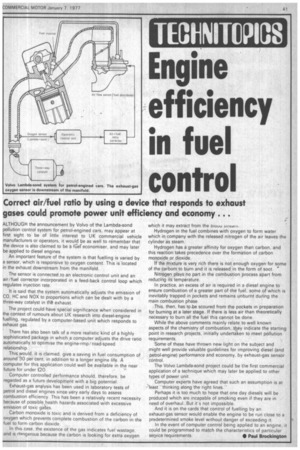Correct air/fuel ratio by using a device that responds to
Page 43

If you've noticed an error in this article please click here to report it so we can fix it.
exhaust gases could promote power unit efficiency and economy . . .
ALTHOUGH the announcement by Volvo of the Lambda-sond pollution control system for petrol-engined cars. may appear at first sight to be of little interest to UK commercial vehicle manufacturers or operators, it would be as well to remember that the device is also claimed to be 8 ft-lei-economiser: and may later be applied to diesel engines_
An important feature of the system is that fuelling is varied by a sensor, which is responsive to oxygen content. This is located in the exhaust downstream from the manifold.
The sensor is connected to an electronic control unit and an air/fuel corrector incorporated in a feed-back control loop which regulates injection rate.
It is said that the system automatically adjusts the emission of CO.. HC and NOX to proportions which can be dealt with by a three-way catalyst in flit exhaust The project could have special significance when considered in the context of rumours about UK research into diesel-engine fuelling, regulated by a computer-based unit which responds to exhaust gas.
There has also been talk of a more realistic kind of a highly sophisticated package in which a computer adjusts the drive ratio automatically to optimise the engine-rmp/road-speed relationship.
This, would. it is claimed, give a saving in fuel consumption of arounc00 per cent, in addition to a longer engine life A computer for this application could well be available in the near future for under £20.
Computer controlled performance should, therefore, be regarded as a future development with a big potential.
Exhaust-gas analysis has been used in laboratory tests of petrol and diesel engines since very early days to assess combustion efficiency. This has been a relatively recent necessity because of possible health hazards associated with excessive emission of toxic g8es.
Carbon monoxide is toxic and is derived from a deficiency of oxygen which prevents complete combustion of the carbon in the fuel to form carbon dioxide In this case. the existence of the gas indicates fuel wastage, and is rlangerous because the carbon is looking for extra oxygen
which it may extract from the °look, Li ed I II.
Hydrogen in the fuel combines with oxygen to form water which in company with the released nitrogen of the air leaves the cylinder as steam.
Hydrogen has a greater affinity for oxygen than carbon, and this reaction takes precedence over the formation of carbon monoxide or dioxide.
If the mixture is very rich there is not enough oxygen for some of the carbom to burn and it is released in the form of soot.
Nitrogen plays no part in the combustion process apart from reducing its temperature.
In practice, an excess of air is required in a diesel engine to ensure combustion of a greater part of the fuel, some of which is inevitably trapped in pockets and remains unburnt during the main combustion phase.
This, then, has tote scoured from the pockets in preparation for burning at a later stage. If there is less air than theoretically necessary to burn all the fuel this cannot be done.
While the above comments mainly relate to well known aspects of the chemistry of combustion, they indicate the starting point in research projects, initially undertaken to meet pollution requirements.
Some of these have thrown new light on the subject and might well provide valuable guidelines for improving diesel (and petrol-engine) performance and economy, by exhaust-gas sensor control_ The Volvo Lambda-sond project could be the first commercial application of a technique which may later be applied to other types of power unit.
, Computer experts have agreed that such an assumption is at ,-least "thinking along the right lines.
Perhaps it is too much to hope that one day diesels will be produced which are incapable of smoking even if they are in need of overhaul. But it's not impossible.
And it is on the cards that control of fuelling by an exhaust-gas sensor would enable the engine to be run close to a predetermined smoke level without danger of exceeding it.
In the event of computer control being applied to an engine, it could be programmed to match the characteristics of particular ser,vice requirements. • Paul Brockington




















































































